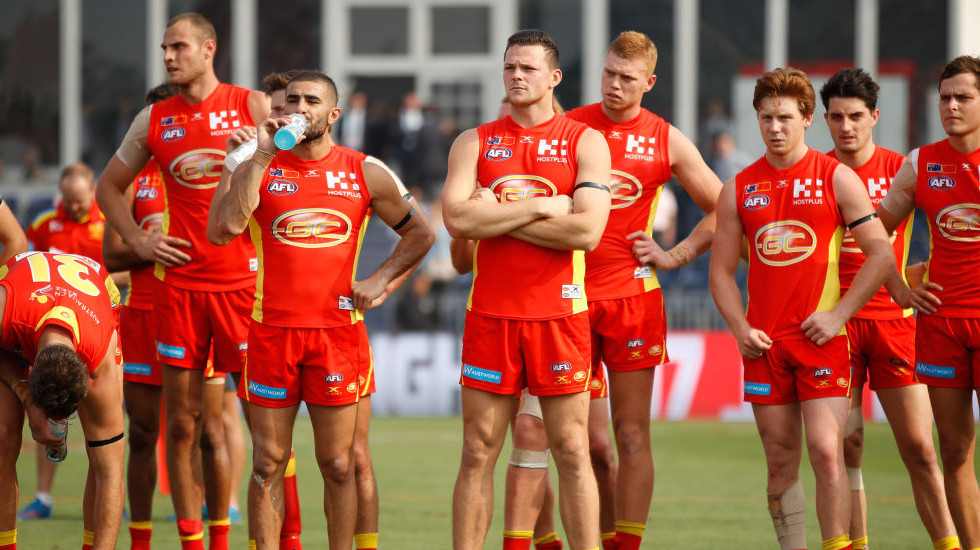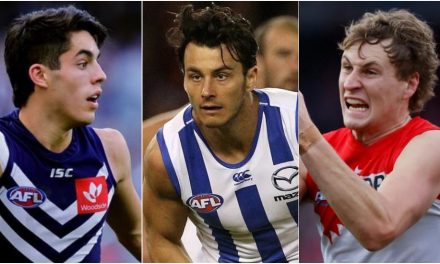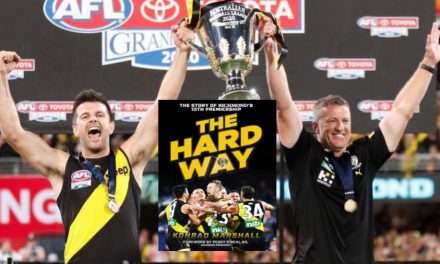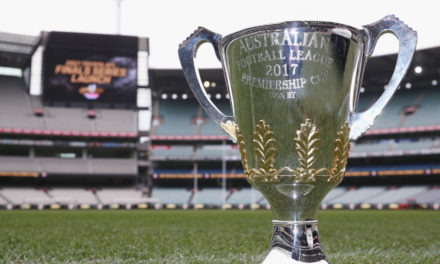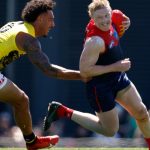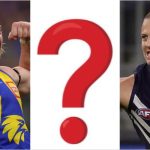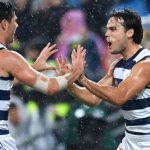Standing still: As Gold Coast reaches the end of another disappointing season, success for the Suns seems as far away as ever. Photo: AFL MEDIA
Ain’t no sunshine where Gold Coast have gone
When it comes to sliding door moments in the AFL, not many are as consequential as Gary Ablett’s shoulder injury in round 16 of the 2014 season.
During this fateful clash with Collingwood, Gold Coast’s reigning Brownlow Medallist dislocated his left shoulder and would be forced to sit out the rest of the year.
On that day, the Suns still managed a courageous and impressive five-point victory, which had them a game inside the top eight and poised for the first finals series in their history. Ablett’s injury, however, would prove a disaster. And not just for 2014.
Without their star captain, who was averaging 32 disposals a game and had already kicked 24 goals, the Suns’ season fell apart. They would win only one of their last seven games to finish the 12th.
The club has moved on two coaches since then. First Guy McKenna, replaced by Rodney Eade, and now Eade himself, short of three seasons in charge. Deep-rooted cultural issues among the playing group have been exposed.
And the Suns haven’t had even a sniff of finals since. Indeed, they’ve won only 17 of 72 games since Ablett first injured his shoulder.
But to what extent is the Suns’ plight due to bad luck, and how much due to the club’s own incompetence?
While the Suns’ dire run of injuries and those off-field issues have been well documented, their list management strategy has also left a lot to be desired.
While the Suns were able to load up on talented youth, of their initial intake of uncontracted player selections, only Ablett, who seems destined to return to his native Geelong, Jarrod Harbrow and Michael Rischitelli remain, most of the others struggling to have any impact.
Campbell Brown was sacked by the club in acrimonious circumstances in late 2013, Jared Brennan never reached his star potential and Nathan Bock managed only 27 games before retiring.
The national draft is where the Suns should have shone their brightest (pardon the pun), given the vast concessions they were gifted, but their selections have too often failed to hit the mark.
Too many of the Suns’ talented picks have been either injury-prone, inconsistent or left the club. This is encapsulated by the club’s initial national draft haul from 2010, where the Suns were given the top three picks.
Number one selection David Swallow has battled injuries, which have prevented him blossoming into the star he might have become. No-one disputes the prodigious of that year’s second pick Harley Bennell, but after numerous off-field issues and injury, he’s only just played his first game at Fremantle after nearly two years. No. 3 Sam Day hasn’t even got on the park this season after dislocating a hip.
When Jack Martin was taken at No.1 in the 2012 mini-draft, he was heralded as having the potential to be “the greatest Aboriginal player of all time” by Brisbane legend Chris Johnson. But Martin has shown only glimpses of his undisputed talent in 65 games now.
Of Gold Coast’s 16 first-round selections from 2010 to 2014, only Tom Lynch stands out as a genuine A-grade player, with perhaps Kade Kolodjashnij and Peter Wright having the potential to join him.
Others who might have are no longer at the club, which is another major issue, Gold Coast’s inability to retain star players.
In 2014, Ablett sat in the midst of a formidable young midfield, flanked by potential A-graders in Jaeger O’Meara and Dion Prestia. All three would finish top five in that year’s best and fairest. And the departures of the latter pair have left a gaping hole in the Suns’ engine room, which has never come close to being filled.
Of course, Gold Coast’s failures have also been amplified further by the success of the AFL’s other newest franchise, Greater Western Sydney, one year younger than the Suns, but about to head into a second successive finals series.
It’s true the Giants were given even more first-round draft picks than the Suns. But they have also haemorrhaged a significant number of talented players, including Adam Treloar, Taylor Adams and Tom Boyd.
Of GWS’s 10 first round draft picks from 2011-2013 that remain, six are either already A-graders or well on their way there.
Jon Patton, Stephen Coniglio, Nick Haynes, Toby Greene, Lachie Whitfield and Josh Kelly form the backbone of a side already in premiership contention, and all are 24 or younger.
All have a consistency of performance most of the Suns’ young guns have decidedly lacked. They’re stronger-bodied, too, a GWS trademark even in the club’s infancy, when weekly thrashings were par for the course.
Those differences speak to the fundamental difference between the way GWS and Gold Coast built their lists, the Giants seemingly placing a greater premium on strength, Gold Coast appearing to have no further parameters other than sheer talent.
It’s a course GWS continues to pursue with success. The Giants senior recruits are hard-nosed, and durable. Co-captain Callan Ward, All-Australian defender Heath Shaw and powerhouse ruckman Shane Mumford all players you would love to go into battle with.
The list of talented but inconsistent and/or injury-prone players recruited to Gold Coast is longer, names like O’Meara, Martin, Swallow, Day, Grant, Bock and Brennan just a sample.
And as another disappointing season draws to a close, it’s not just about a team at the crossroads, but arguably, an entire club. Crowds remain poor, interest in the team is waning, and those fortunes don’t look like turning around any time soon.
As futile an exercise as it is, you could forgive those connected with Gold Coast for looking back on that July afternoon a bit over three years ago and pondering the “what ifs”.
Had Ablett not been injured, the Suns would have made finals. Had they made finals, McKenna would have kept his job. Had the club’s first coach had a longer tenure off the back of that historic finals achievement, the Suns would have been a far more stable organisation, and most likely, a more successful one.
That winning culture would have made it far harder for the likes of Ablett, O’Meara and Prestia to leave, instead developing an even greater understanding as one of the premier midfields of the competition.
Alas, that door slid the wrong way. But so, too, have the Suns been architects of their own demise. And bad luck coupled with bad list decisions do not a recipe for success make.
We all know the hardly encouraging history of previous sporting franchises based in one of Australia’s most beautiful places, but in sporting terms, seemingly something of a Bermuda Triangle.
And seven seasons down the track with little glimpse yet of any impending riches, it’s going to take something special on and off the field if the sun isn’t to set on this particular AFL venture for good.

